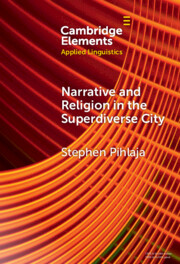Element contents
Narrative and Religion in the Superdiverse City
Published online by Cambridge University Press: 11 April 2024
Summary
- Type
- Element
- Information
- Series: Elements in Applied LinguisticsOnline ISBN: 9781009406994Publisher: Cambridge University PressPrint publication: 09 May 2024
References
- 1
- Cited by

